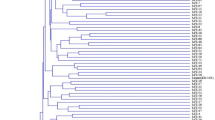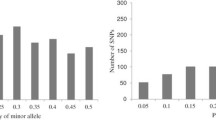Abstract
Restriction fragment length polymorphisms (RFLPs) and one morphological marker were used to investigate quantitative trait loci (QTL) for morphological and physiological traits evaluated on 150 F2∶3 maize (Zea mays L.) lines derived from the cross of elite U.S. Corn Belt inbreds Mo17 and H99. F2∶3 lines were grown in a replicated experiment and evaluated for plant and ear heights and flowering traits. QTL were identified for each trait, and genetic effects were determined. Estimated gene action for the flowering traits was predominantly overdominance. Both parents contributed toward increased values for anthesis and silk emergence. QTL for increased plant and ear heights were usually contributed by the taller parent, Mo17. Estimated gene action for these traits was mainly partial to overdominance. QTL for plant height were located in the vicinity of loci defined by alleles with qualitative effects on plant height.
Similar content being viewed by others
References
Abler BSB, Edwards MD, Stuber CW (1991) Isoenzymatic identification of quantitative trait loci in crosses of elite maize inbreds. Crop Sci 31:267–274
Beavis WD, Grant D (1991) A linkage map based on information from four F2 populations of maize (Zea mays). Theor Appl Genet 82:636–644
Beavis WD, Grant D, Albertsen M, Fincher R (1991) Quantitative trait loci for plant height in four maize populations and their associations with qualitative genetic loci. Theor Appl Genet 83:141–145
Burr B, Burr FA, Thompson KH, Albertsen MC, Stuber CW (1988) Gene mapping with recombinant inbreds in maize. Genetics 118:519–526
Coe EH, Hoisington DA, Neuffer MG (1990) Linkage map of corn (maize) (Zea mays L.) (2n=20). In: O'Brien SJ (ed) Genetic maps, 5th edn. Cold Spring Harbor Laboratory Press, Cold Spring Harbor, New York, pp 6.39–6.67
Cochran WG, Cox GM (1957) Experimental designs. John Wiley & Sons, New York
Diers BW, Keim P, Fehr WR, Shoemaker RC (1992) RFLP analysis of soybean seed protein and oil content. Theor Appl Genet 83:608–612
Doebley J, Stec A, Wendel J, Edwards M (1990) Genetic and morphological analysis of a maize-teosinte F2 population: implications for the origin of maize. Proc Natl Acad Sci USA 87:9888–9892
Edwards MD, Stuber CW, Wendel JF (1987) Molecular-marker-facilitated investigations of quantitative-trait loci in maize. I. Numbers, genomic distribution and types of gene action. Genetics 116:113–125
Edwards MD, Helentjaris T, Wright S, Stuber CW (1992) Molecular-marker-facilitated investigations of quantitative trait loci in maize. 4. Analysis based on genome saturation with isozyme and restriction fragment length polymorphism markers. Theor Appl Genet 83:765–774
Feinberg AP, Vogelstein B (1983) A technique for radiolabelling DNA restriction fragment length polymorphisms to high specific activity. Anal Biochem 132:6–13
Hallauer AR (1990) Methods used in developing maize inbreds. Maydica 35:1–16
Hallauer AR, Miranda JB (1988) Quantitative genetics in maize breeding, 2nd edn. Iowa State University Press, Ames, Iowa
Hanson WD (1959) Minimum family sizes for the planning of genetic experiments. Agron J 51:711–715
Knapp SJ, Stroup WW, Ross WM (1985) Exact confidence intervals for heritability on a progeny mean basis. Crop Sci 25:192–194
Knott SA, Haley CS (1992) Aspects of maximum likelihood methods for the mapping of quantitative trait loci in line crosses. Genet Res 60:139–151
Lande R, Thompson R (1990) Efficiency of marker-assisted selection in the improvement of quantitative traits. Genetics 124:743–756
Lander ES, Botstein D (1989) Mapping Mendelian factors underlying quantitative traits using RFLP linkage maps. Genetics 121:185–199
Lander ES, Green P, Abrahamson J, Barlow A, Daly MJ, Lincoln SE, Newburg L (1987) MAPMAKER: An interactive computer package for constructing primary genetic linkage maps of experimental and natural populations. Genomics 1:174–181
Lee M, Veldboom LR (1993) Quantitative genetic variation near an1 and bx1. Maize Genet Coop Newsl 67:6
Lee M, Veldboom L, Scanlon M, Myers A, James M, Robertson D (1991) Mutator-tagged defective kernel mutants as putative QTL for kernel size. Maize Genet Coop Newsl 65:10–11
Mackay TFC, Langley CH (1990) Molecular and phenotypic variation in the achaete-scute region of Drosophila melanogaster. Nature 348:64–66
Mather K, Jinks JL (1971) Biometrical genetics. Chapman and Hall, London
Melchinger AE, Messmer MM, Lee M, Woodman WL, Lamkey KR (1991) Diversity and relationships among U.S. maize inbreds revealed by restriction fragment length polymorphisms. Crop Sci 31:669–678
Moll RH, Lindsey MF, Robinson HF (1964) Estimates of genetic variances and level of dominance in maize. Genetics 49:411–423
Ottaviano E, Sari Gorla M, Pè E, Frova C (1991) Molecular markers (RFLPs and HSPs) for the genetic dissection of thermotolerance in maize. Theor Appl Genet 81:713–719
Paterson AH, Lander ES, Hewitt JD, Peterson S, Lincoln SE, Tanksley SD (1988) Resolution of quantitative traits into Mendelian factors by using a complete linkage map of restriction fragment length polymorphisms. Nature 335:721–726
Paterson AH, Damon S, Hewitt JD, Zamir D, Rabinowitch HD, Lincoln SE, Lander ES, Tanksley SD (1991) Mendelian factors underlying quantitative traits in tomato: Comparison across species, generations, and environments. Genetics 127:181–197
Reiter RS, Coors JG, Sussman MR, Gableman WH (1991) Genetic analysis of tolerance to low-phosphorus stress in maize using restriction fragment length polymorphisms. Theor Appl Genet 82:561–568
Robertson DS (1985) A possible technique for isolating genic DNA for quantitative traits in plants. J Theor Biol 117:1–10
Russell WA, Hallauer AR, Lamkey KR, White PR (1989) Iowa experimental corn trials. Iowa Coop Ext Serv Publ AG129, Ames, Iowa
Saghai-Maroof MA, Soliman KM, Jorgenson R, Allard RA (1984) Ribosomal DNA spacer length polymorphisms in barley: Mendelian inheritance, chromosomal location and population dynamics. Proc Natl Acad Sci USA 81:8014–8018
Sax K (1923) The association of size differences with seed coat pattern and pigmentation in Phaseolus vulgaris. Genetics 8:552–560
Schön CC, Lee M, Melchinger AE, Guthrie WD, Woodman WL (1993) Mapping and characterization of quantitative trait loci affecting resistance against second generation European corn borer in maize with the aid of RFLPs. Heredity 70:648–659
Searle SR (1971) Linear models. John Wiley and Sons, New York
Shapiro SS, Wilk MB (1965) An analysis of variance for normality (complete samples). Biometrika 52:591–611
Stuber CW, Edwards MD, Wendel JF (1987) Molecular marker-facilitated investigations of quantitative trait loci in maize. II. Factors influencing yield and its component traits. Crop Sci 27:639–648
Stuber CW, Lincoln SE, Wolff DW, Helentjaris T, Lander ES (1992) Identification of genetic factors contributing to heterosis in a hybrid from two elite maize inbred lines using molecular markers. Genetics 132:823–839
Utz HF (1987) PLABSTAT: A computer program for statistical analysis of plant breeding experiments. University of Hohenheim, Stuttgart, FRG
Weber D, Helentjaris T (1989) Mapping RFLP loci in maize using B-A translocations. Genetics 121:583–590
Young ND, Tanksley SD (1989) RFLP analysis of the size of chromosomal segments retained around the Tm-2 locus of tomato during backcross breeding. Theor Appl Genet 77:353–359
Yu ZH, Mackill DJ, Bonham JM, Tanksley SD (1991) Tagging genes for blast resistance in rice via linkage to RFLP markers. Theor Appl Genet 81:471–476
Author information
Authors and Affiliations
Additional information
Communicated by A. R. Hallauer
Rights and permissions
About this article
Cite this article
Veldboom, L.R., Lee, M. & Woodman, W.L. Molecular marker-facilitated studies in an elite maize population: I. Linkage analysis and determination of QTL for morphological traits. Theoret. Appl. Genetics 88, 7–16 (1994). https://doi.org/10.1007/BF00222387
Received:
Accepted:
Issue Date:
DOI: https://doi.org/10.1007/BF00222387




